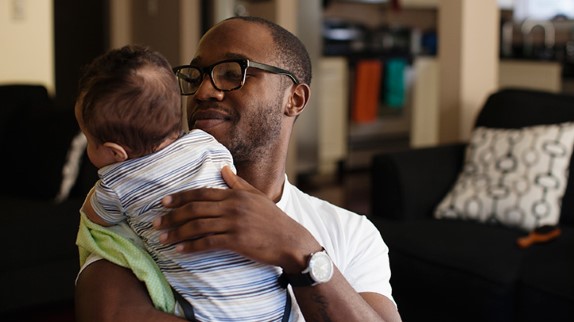Does your baby fuss and get cranky during or after feedings? It’s likely because she's swallowed a bit of air with that milk, making her feel uncomfortably full. Burping your baby is an important feeding step and can help her feel better.
Try these burping tips and positions to bring up the air and make space for baby’s full meal.
How to burp your baby
Try following these steps to help burp your baby successfully:
- About halfway through feeding, position your baby on your shoulder, face-down on your lap or sitting up (more on that below).
- Protect your clothes by always keeping a burp cloth or bib between your outfit and baby’s mouth.
- Give her a gentle pat or rub on the left side of her back, which is where your little one's stomach is located. This may get the burp up for most babies, but some need a slightly firmer hand.
Why do I need to burp my baby?
It’s important to burp baby at each feeding — even if she's sleeping. When your baby drinks, she can't help but swallow a little air along with her breast milk or formula. But having those air bubbles trapped in her tummy can make her feel uncomfortable and full before she's really finished eating. That’s why burping baby to bring up any excess air is such an important part of the feeding process.
If she's fussing during a feeding due to this discomfort, it'll also cause her to swallow more air — leading to more crankiness and possibly spitting up. If she starts protesting during a feeding, try burping baby right away to see if it’s an air bubble in her tummy that’s causing her distress.
What are the best positions for burping baby?
There are three basic ways to burp a baby: on your shoulder, face-down on your lap or sitting up. It’s a good idea to try all three to see which gets the job done best for your little one.
Read This Next
- On your shoulder: Hold your baby firmly against your shoulder. Support her bottom with one hand, and pat or rub her back with the other.
- Face-down on your lap: Place your baby tummy-down across your lap (her stomach will be on one of your legs, her head on the other, turned sideways, with her head supported and slightly higher than her chest). With one hand securely holding baby, pat or rub her back with the other.
- Sitting up: Hold your baby in a seated position on your lap, leaning slightly forward. Support baby’s head and chest with one arm while you pat or rub with the other.
- Walking: Once your baby has good head control, you can try holding her upright in front of you, facing out, while you stand and walk. Put one hand under her bottom and the other arm across her tummy to apply light pressure. The motion may help give an additional release of any trapped air bubbles.
How often should I burp my baby?
How often you burp baby depends on how you’re feeding her:
- When bottle-feeding, burp baby at least once, about halfway through feeding or after every 2 or 3 ounces, or more often if she seems fussy or is taking a long time.
- When breastfeeding, burp when you switch from one breast to the other to make room for more milk. Keep in mind that a baby who’s swallowed air may stop eating and refuse to switch breasts simply because she feels uncomfortably full. Is your newborn managing only one breast at a time? Burp mid-feed on the same breast.





 Trending On What to Expect
Trending On What to Expect






